Before I could start the tunnel structure, which would be the base for the future mountain, I had to finish the track. First was paint. I experimented for a few days to find a method that covered quickly, and looked effective. Since my layout is right beside my furnace and hot water tank, and there is no ventilation, spray paint and enamels were out of the question. That left me with hand brushing with water-based acrylics.
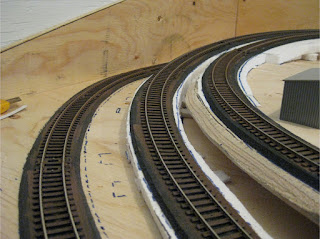
To paint the track, I used Burnt Umber acrylic, mixed with a bit of grey and thinned it with 25% water and 25% isopropyl alcohol (70%). This mixture covered well, and dried quite uniformly on the ties and in the webs of the rails. I had to use extreme caution when painting the turnouts, making sure I moved them frequently while the paint dried so they didn’t get stuck in place. Once the paint was dry, I cleaned any paint off the top of the rails using a fine grit sanding block.

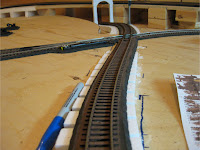
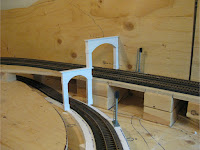

I used Woodland Scenics Medium Buff ballast. This, like most everything else, was my first time ballasting track, so doing it in the tunnel sections, where it would be a lot less noticeable, was a perfact place to start.
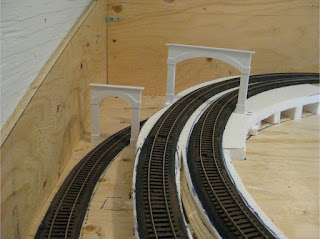
I used a method that I found to be most popular in my online research. This method is to lay your ballast on the track and shoulders, then use a brush to level it between the ties and make it uniform. Then, using alcohol and an eye-dropper, gently wet the ballast. This reduces the water tension when adding the glue, and allows the glue to wick better through the ballast. Once the alcohol soaks in, apply a liberal amount of white glue, thinned 50% with water, and let this soak in as well. Be careful not to add too much glue at once, or your ballast with start to flow away. Once the glue completely dries, about 24 hours later, the ballast will be hard as concrete!

One thing I learned from this first ballast attempt is to not use too much ballast. You can always add more, but using too much makes things messy, and it’s almost impossible to brush all of the granules off of the tops of the ties. Model Railroader Magazine has a really good article in their February 2011 magazine about ballasting track. They explain a 2-part application process of ballasting, where you first apply glue, then ballast, then re-apply ballast and glue again. This method looks really nice in the end. I just might try this when I complete the rest of my track.
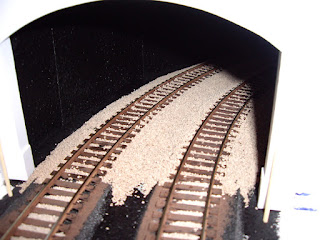
With the track and tunnel portals complete, I can finally start building the large mountain which the 2 tunnels will run through. Before I can build the mountain, I need to build each tunnel structure, which the mountain scenery will sit on. Each tunnel, which will include the supports, the walls, and a common ceiling, and will act as the base for the mountain.
The first task is accessing de-railed trains inside the mountain. The double wide tunnel is wide and short enough that I can access the inside of the tunnel from either side. The smaller, single tunnel which goes under the double tunnel, is the opposite situation. To solve this, I cut an opening in the benchwork right beside the track. This will allow me at least some room to retrieve a train if it becomes stuck in this tunnel.

Tunnels are dark, so to keep things as dark as possible, everything inside the portals was painted black, with no exceptions. Since there were sections of the tunnel that didn’t have a complete wall, it was important that everything was blacked out, so nothing could be seen inside the tunnels. I used cheap black acrylic paint from the dollar store, which worked great for this purpose.



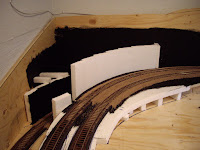
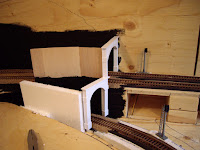

The entrance to each portal is the most visible, so it was important that there were complete side walls on both sides of each portal, extending far enough into the tunnel so you could not see that it ended. As seen in the top portal, right side of the mountain, I used 1/16” wood craft board as a divider from the lower tunnel portal. This was to prevent light from either of the portal entrances, showing through to either the top or lower tunnels. I had to use the thin 1/16” wood craft board as the foam I had was too thick to use without interfering with the lower tunnel.

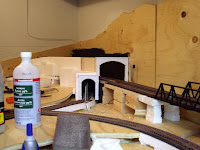
Once I ensured the tunnel portals fit correctly, and were temporarily in place, I did a final visual inspection to make sure everything was pitch black inside. I then used a large template to cut a solid one-piece foam roof for the entire tunnel structure. I attached foam supports on the back-board, secured with screws and glue, to support the back and left edge of the roof. I painted the roof and foam supports black, and glued it into place.


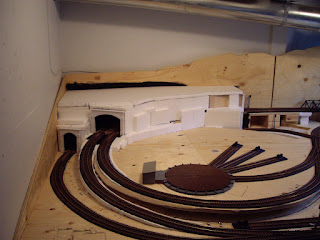


0 (mga) komento:
Mag-post ng isang Komento